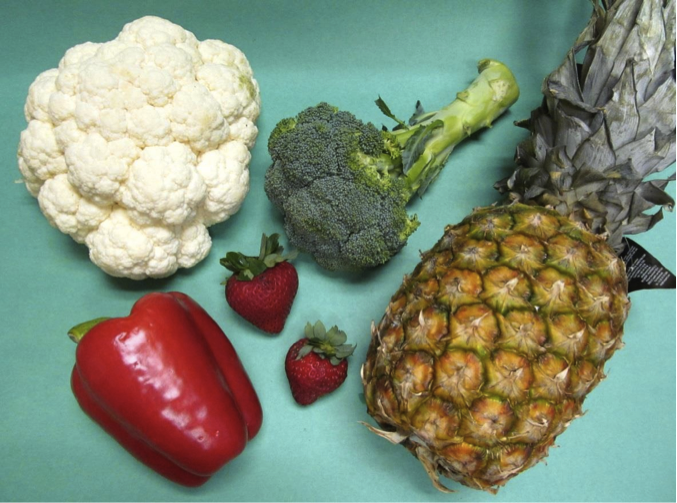Don Mercer
Vitamin C is an essential nutrient that is readily found in numerous fruits and vegetables. Most people tend to think of orange juice as their primary source of vitamin C, but there are other foods which contain a significant amount as well. Surprisingly, some vegetables like broccoli, cauliflower, and Brussels sprouts contain more vitamin C on a “per 100 g” basis than orange juice – but they really don’t stand much of a chance competing with the overall appeal of a cold glass of freshly squeezed OJ.

Cauliflower, broccoli, pineapple, peppers, and strawberries are all sources of vitamin C
Many of the reactions occurring at the cellular level in the human body require the presence of vitamin C (or ascorbic acid, as it is also known). Sailors in the British Navy were prone to suffering the effects of scurvy which we now know was due to a lack of vitamin C. In the early1800s, lime juice was added to each sailor’s daily ration of rum to alleviate the situation – hence the origin of the slang term “limey”.
In solution, vitamin C reacts quickly with any dissolved oxygen that is present. For this reason, it is considered to be an “antioxidant”, which from a dietary perspective has some definite benefits. Various sources indicate that vitamin C can protect us against immune system deficiencies, cardiovascular disease, pre-natal health problems, eye disease, and even skin wrinkling.
In food processing, the antioxidant properties of vitamin C are particularly important for maintaining the quality of the fruit juices we drink. Oxygen is quite soluble in cold water. Levels of about 13 mg/L (or parts per million) can be found in water at 4°C, which is the temperature of a typical home refrigerator. At room temperature, its concentration is about 8 mg/L. Dissolved oxygen in citrus juices can react with the aromatic oils to create undesirable flavour off-notes and unpleasant odours. In extreme cases, dark brown pigments can be produced when oxygen reacts with natural sugars and other compounds in the juice. However, vitamin C can consume this dissolved oxygen, thereby reducing the problems associated with oxidation.
When manufacturers put fruit juices in bottles or cans, there will often be dissolved oxygen in the juice, along with oxygen in the headspace air at the top of the container. Even with special methods of lowering the initial amount of dissolved and headspace oxygen, the risk of it being present in the container remains. Fortunately, vitamin C in the juice (either naturally occurring, or added by the manufacturer) effectively eliminates the oxygen, and stabilises the juice to maintain its quality over an extended period of time. Juice manufacturers usually make sure there is sufficient vitamin C in the product to account for this initial oxygen and still have enough left to meet the nutritional claims on the package label. Some packaging materials (other than glass and metal) are not totally impervious to the diffusion of air. Over a period of several months, trace amounts of oxygen may diffuse through the packaging material. Vitamin C in the beverage inside the container rapidly consumes this oxygen, avoiding the negative results which otherwise might have occurred.
Vitamin C preparations are also used when freezing fruits such as peaches. Dipping the slices in such a solution after they have been blanched protects them from the deteriorating effects of oxygen. Dipping apple rings in a vitamin C solution, or in lemon juice, can prevent browning during drying. Vitamin C in the lemon juice reacts preferentially with the oxygen in the air and reduces the problems of browning. When you really think about it, the role of vitamin C in our overall health and in maintaining the quality of the food we eat is rather amazing.
Dr Don Mercer is Associate Professor in Food Science, Department of Food Science, University of Guelph, Guelph, Ontario N1G 2W1, Canada; e-mail: dmercer@uoguelph.ca
Permission to reproduce this article is greatly appreciated and acknowledged.
IUFoST Scientific Information Bulletin (SIB)
FOOD FRAUD PREVENTION